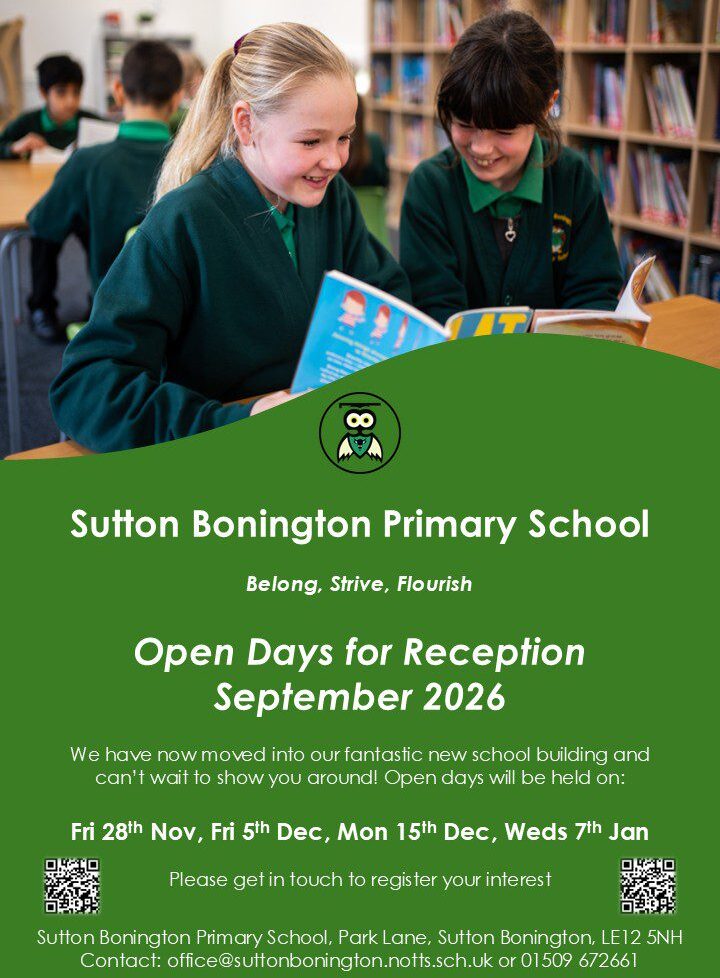Curriculum Intent
At Sutton Bonington Primary School, we teach children that Computing is the study of how computer technology works and how we can use it safely in the wider world. We want to inspire in our learners a passion for computing and a curiosity to learn. We recognise the increasing use of digital technology in everyday life at home, school and in the wider world. We acknowledge that Computing will play a huge part in future generation’s lives and we therefore want our children to become digitally literate and become independent users of digital technologies.
In order to achieve this, our aim is to prepare our children with the skills and knowledge required to access the three core areas of Computing: Computer Science, Information Technology and Digital Literacy. At Sutton Bonington, we also want our children to develop their creativity, resilience and problem-solving skills through Computing lessons. We want to ensure that the use of technology supports learning across the entire curriculum and is accessible to every child. Our aims, therefore, are for children to:
- Use technology safely, responsibly and respectfully to interact with others.
- Deepen their understanding of the use of digital technology in the wider world and understand how it can support us in future careers.
- Be able to communicate ideas effectively, across the curriculum, through the use of devices and applications, e.g. through presenting data and information.
- Develop their ability to use information technology effectively, e.g. through collecting, organising, manipulating and analysing to solve problems.
- Become computational thinkers, including coding for different purposes and using skills and knowledge in other areas of the curriculum.
Our curriculum intent is in line with that of the National Curriculum for Computing.
Curriculum Implementation
Children take part in six Computing units per year, with online safety reoccurring throughout. These are taught within a half term in line with our coverage document.
The units of work are well sequenced to provide a coherent subject scheme that develops children’s computing knowledge, skills and subject disciplines. Units contain approximately 6 lessons. The specific content of each unit is drawn from the iLearn2 scheme of work. This involves three key aspects:
- Computer Science – this covers programming (both block-based and text-based), including computational thinking using web-based software such as Scratch. Pupils across Key Stage 1 and 2 will write code to program physical and on-screen objects, interactive games and use text-based language, such as HTML and Python by the end of Key Stage 2.
- Information Technology – this covers the use of applications to create digital content, including document creation and editing, video making, digital art, graphic design, animation, 3D modelling and website building.
- Digital Literacy – covers skills to find, evaluate, utilise and share using technologies and the Internet. This includes important e-safety and internet research skills, as well as an understanding of computer networks in Key Stage 2.
Children’s work is recorded on their log ins for specific websites and on our iPads and laptops. Our curriculum also recognises that Computing can be taught both as a discrete subject as well as within our wider curriculum. Our school has a bank of iPads and laptops to support the learning of Computing, which contain varied programmes that can be used to meet the three core areas. We also have interactive whiteboards in every classroom to aid and enhance learning. Online safety is an explicit part of our computing curriculum but is also taught through the ‘Media Literacy and Digital Resilience’ section of our PSHE lessons.
Within the Early Years Curriculum, children in Reception experience the Computing curriculum through the ‘personal, social and emotional development’, ‘expressive arts and design’ and ‘understanding the world’ areas of learning.
Adaptations for children with special educational needs and disabilities are made in line with our SEND Curriculum Adaptations document. These may include the use of additional scaffolding, explicit instruction, cognitive and metacognitive strategies, flexible groupings and use of specific resources or technology.
Where possible, opportunities for curriculum enrichment within Computing are exploited. For example, children may receive visits involving specialist workshops, e.g. STEM programming, and they take part in ‘Safer Internet Day’ every year in February.
Opportunities for children’s spiritual, moral, social and cultural development through Computing are also explored where appropriate. For example, pupils’ cultural awareness is developed through exploring problem-solving skills and looking at how differing cultures use the internet. Social responsibility is promoted through developing their skills on a range of software and challenging them to find solutions whilst developing respect for ideas and opinions of others in their team. Children morally consider issues surrounding online safety, have respect for other’s feelings when peer working and explore moral issues around the use of digital technology (copyright and plagiarism). They reflect on the awe and wonder of achievements in IT today to help improve their self-confidence, self-esteem and spiritual development.
Curriculum Impact
By the end of KS2, children will leave with a breadth of knowledge, skills and understanding, in the three core areas (computer science, information technology and digital literacy), to help them use a range of technology in a safe, responsible and respectful way, which that will support them moving on to KS3 and within their everyday lives. Children will have developed their computational thinking and creativity to help them understand and flourish in an ever-changing world. Our children will enjoy using technology to develop their knowledge and skills but also express themselves and their ideas, safely, using different programmes and systems.
We assess the impact of our curriculum through examining children’s work, talking with and questioning children as well as making observations and setting specific tasks. Teacher assessment is ongoing throughout the year with a formal summative assessment made and recorded at the end of the summer term.


